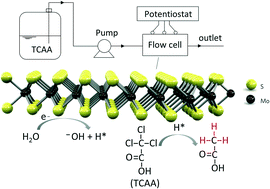当前位置:
X-MOL 学术
›
Environ. Sci.: Nano
›
论文详情
Our official English website, www.x-mol.net, welcomes your
feedback! (Note: you will need to create a separate account there.)
Hierarchical MoS2 nanosheets on flexible carbon felt as an efficient flow-through electrode for dechlorination†
Environmental Science: Nano ( IF 5.8 ) Pub Date : 2017-11-13 00:00:00 , DOI: 10.1039/c7en00925a Li-Zhi Huang 1, 2, 3, 4, 5 , Steen Uttrup Pedersen 5, 6, 7, 8, 9 , Emil Tveden Bjerglund 5, 6, 7, 8 , Paolo Lamagni 5, 6, 7, 8, 9 , Marianne Glasius 5, 6, 7, 8 , Hans Christian Bruun Hansen 8, 10, 11, 12 , Kim Daasbjerg 5, 6, 7, 8, 9
Environmental Science: Nano ( IF 5.8 ) Pub Date : 2017-11-13 00:00:00 , DOI: 10.1039/c7en00925a Li-Zhi Huang 1, 2, 3, 4, 5 , Steen Uttrup Pedersen 5, 6, 7, 8, 9 , Emil Tveden Bjerglund 5, 6, 7, 8 , Paolo Lamagni 5, 6, 7, 8, 9 , Marianne Glasius 5, 6, 7, 8 , Hans Christian Bruun Hansen 8, 10, 11, 12 , Kim Daasbjerg 5, 6, 7, 8, 9
Affiliation

|
MoS2, a layered transition metal dichalcogenide, is well-known as an efficient catalyst for the hydrogen evolution reaction. For the first time, we show that MoS2 is also a promising electrocatalyst for reductive dehalogenation of chloro-substituted carboxylic acids in water. MoS2 nanosheets were grown directly on flexible/soft carbon felt using a facile hydrothermal method. The MoS2 nanosheet loaded carbon felt was used as flow-through electrode for reductive dechlorination of trichloroacetic acid under environmentally relevant conditions resulting in a much more efficient process than using metal electrodes. Atomic hydrogen produced from water reduction at the MoS2 surface can be exploited to accomplish a complete dehalogenation, yet with a dramatic drop in the Faradaic efficiency due to the concomitant dihydrogen evolution. Doping of the MoS2 catalyst with transition metals resulted in an increase in the Faradaic efficiency as well as the complete dechlorination of trichloroacetic acid to acetic acid. The edge sites of MoS2 are believed to be responsible for the indirect dechlorination involving atomic hydrogen. With the cobalt doped MoS2 catalyst, 100% full dechlorination was accomplished at an applied potential of −1.1 V vs. Ag/AgCl using a flow rate of 1 mL min−1. The catalyst synthesis, electrode preparation, and setup of the electrochemical flow cell are straightforward and readily up-scaled, demonstrating the potential of this methodology in practical applications.
中文翻译:

柔性碳毡上的 分层MoS 2纳米片,可作为有效的脱氯流通电极†
众所周知,MoS 2是一种层状过渡金属二硫化二氢,是一种有效的制氢反应催化剂。首次,我们表明MoS 2还是一种有希望的用于水中氯取代羧酸还原脱卤的电催化剂。使用方便的水热方法,将MoS 2纳米片直接在柔性/软碳毡上生长。负载有MoS 2纳米片的碳毡被用作流通电极,用于在与环境相关的条件下对三氯乙酸进行还原性脱氯,这导致比使用金属电极更有效的过程。MoS 2还原水产生的原子氢表面可以被用来完成完全的脱卤作用,但由于伴随的二氢释放,法拉第效率却急剧下降。MoS 2催化剂中过渡金属的掺杂导致法拉第效率的提高以及三氯乙酸向氯乙酸的完全脱氯。据认为,MoS 2的边缘部位是涉及原子氢的间接脱氯的原因。使用钴掺杂的MoS 2催化剂,在相对于Ag / AgCl的-1.1 V施加电势下,以1 mL min -1的流速完成了100%的完全脱氯。催化剂的合成,电极的制备以及电化学流动池的设置简单明了,易于扩大规模,证明了该方法在实际应用中的潜力。
更新日期:2017-11-13
中文翻译:

柔性碳毡上的 分层MoS 2纳米片,可作为有效的脱氯流通电极†
众所周知,MoS 2是一种层状过渡金属二硫化二氢,是一种有效的制氢反应催化剂。首次,我们表明MoS 2还是一种有希望的用于水中氯取代羧酸还原脱卤的电催化剂。使用方便的水热方法,将MoS 2纳米片直接在柔性/软碳毡上生长。负载有MoS 2纳米片的碳毡被用作流通电极,用于在与环境相关的条件下对三氯乙酸进行还原性脱氯,这导致比使用金属电极更有效的过程。MoS 2还原水产生的原子氢表面可以被用来完成完全的脱卤作用,但由于伴随的二氢释放,法拉第效率却急剧下降。MoS 2催化剂中过渡金属的掺杂导致法拉第效率的提高以及三氯乙酸向氯乙酸的完全脱氯。据认为,MoS 2的边缘部位是涉及原子氢的间接脱氯的原因。使用钴掺杂的MoS 2催化剂,在相对于Ag / AgCl的-1.1 V施加电势下,以1 mL min -1的流速完成了100%的完全脱氯。催化剂的合成,电极的制备以及电化学流动池的设置简单明了,易于扩大规模,证明了该方法在实际应用中的潜力。











































 京公网安备 11010802027423号
京公网安备 11010802027423号